Allen-Bradley ControlLogix 1756-OF4 Installation Instructions Manual
- Taper
- Installation Instructions Manual

Publication 1756-IN016B-EN-P - November 2003
Installation Instructions
ControlLogix Voltage/Current Output Module
Catalog Number 1756-OF4
Obtain a User Manual
This product also has a user manual (pub. no. 1756-UM009). To view
it, visit www.ab.com/manuals
or www.theautomationbookstore.com.
To purchase a manual, you can:
• contact your distributor or Rockwell Automation representative
• visit www.theautomationbookstore.com
and place an order
• call 800.963.9548 (USA/Canada) or 001.320.725.1574 (outside
USA/Canada)
To: See page:
Identify the Module Components 7
Note the Power Requirements 7
Install the Module 8
Key the Module and Removable Terminal Block/Interface Module 9
Wire the Removable Terminal Block 10
Wire the Module 13
Assemble the Removable Terminal Block and the Housing 15
Install the Removable Terminal Block onto the Module 15
Check the Indicators 16
Remove the Removable Terminal Block from the Module 17
Remove the Module 17
See Specifications 18
AB PLCs

2 ControlLogix Voltage/Current Output Module
Publication
1756-IN016B-EN-P - November 2003
Important User Information
Solid state equipment has operational characteristics differing from those of electromechanical
equipment. Safety Guidelines for the Application, Installation and Maintenance of Solid State Controls
(Publication SGI-1.1 available from your local Rockwell Automation sales office or online at
http://www.ab.com/manuals/gi) describes some important differences between solid state equipment
and hard-wired electromechanical devices. Because of this difference, and also because of the wide
variety of uses for solid state equipment, all persons responsible for applying this equipment must
satisfy themselves that each intended application of this equipment is acceptable.
In no event will Rockwell Automation, Inc. be responsible or liable for indirect or consequential damages
resulting from the use or application of this equipment.
The examples and diagrams in this manual are included solely for illustrative purposes. Because of the
many variables and requirements associated with any particular installation, Rockwell Automation, Inc.
cannot assume responsibility or liability for actual use based on the examples and diagrams.
No patent liability is assumed by Rockwell Automation, Inc. with respect to use of information, circuits,
equipment, or software described in this manual.
Reproduction of the contents of this manual, in whole or in part, without written permission of Rockwell
Automation, Inc. is prohibited.
Throughout this manual we use notes to make you aware of safety considerations.
WARNING
Identifies information about practices or circumstances that can cause an explosion in a
hazardous environment, which may lead to personal injury or death, property damage,
or economic loss.
IMPORTAN
T
Identifies information that is critical for successful application and understanding of the
product.
ATTENTION
Identifies information about practices or circumstances that can lead to personal injury
or death, property damage, or economic loss. Attentions help you:
• identify a hazard
• avoid a hazard
• recognize the consequence
SHOCK HAZAR
D
Labels may be located on or inside the drive to alert people that dangerous voltage may
be present.
BURN HAZARD
Labels may be located on or inside the drive to alert people that surfaces may be
dangerous temperatures.

ControlLogix Voltage/Current Output Module 3
Publication
1756-IN016B-EN-P - November 2003
Environment and Enclosure
Prevent Electrostatic Discharge
ATTENTION
This equipment is intended for use in a Pollution Degree 2 industrial environment, in
overvoltage Category II applications (as defined in IEC publication 60664-1), at altitudes
up to 2000 meters without derating.
This equipment is considered Group 1, Class A industrial equipment according to
IEC/CISPR Publication 11. Without appropriate precautions, there may be potential
difficulties ensuring electromagnetic compatibility in other environments due to
conducted as well as radiated disturbance.
This equipment is supplied as "open type" equipment. It must be mounted within an
enclosure that is suitably designed for those specific environmental conditions that will
be present and appropriately designed to prevent personal injury resulting from
accessibility to live parts. The interior of the enclosure must be accessible only by the
use of a tool. Subsequent sections of this publication may contain additional
information regarding specific enclosure type ratings that are required to comply with
certain product safety certifications.
NOTE: See NEMA Standards publication 250 and IEC publication 60529, as applicable,
for explanations of the degrees of protection provided by different types of enclosure.
Also, see the appropriate sections in this publication, as well as the Allen-Bradley
publication 1770-4.1 ("Industrial Automation Wiring and Grounding Guidelines"), for
additional installation requirements pertaining to this equipment.
ATTENTION
This equipment is sensitive to electrostatic discharge, which can cause internal
damage and affect normal operation. Follow these guidelines when you handle this
equipment:
• Touch a grounded object to discharge potential static.
• Wear an approved grounding wriststrap.
• Do not touch connectors or pins on component boards.
• Do not touch circuit components inside the equipment.
• If available, use a static-safe workstation.
• When not in use, store the equipment in appropriate static-safe packaging.
AB PLCs

4 ControlLogix Voltage/Current Output Module
Publication
1756-IN016B-EN-P - November 2003
Removal and Insertion Under Power
Be sure that power is removed or the area is nonhazardous before
proceeding. Repeated electrical arcing causes excessive wear to
contacts on both the module and its mating connector. Worn contacts
may create electrical resistance that can affect module operation.
European Hazardous Location Approval
If you install the module in a European Zone 2 location, consider:
WARNING
When you insert or remove the module while backplane
power is on, an electrical arc can occur. This could cause
an explosion in hazardous location installations.
European Zone 2 Certification (The following applies when the product bears the
EEx Marking)
This equipment is intended for use in potentially explosive atmospheres as defined by
European Union Directive 94/9/EC.
The LCIE (Laboratoire Central des Industries Electriques) certifies that this equipment has
been found to comply with the Essential Health and Safety Requirements relating to the
design and construction of Category 3 equipment intended for use in potentially explosive
atmospheres, given in Annex II to this Directive. The examination and test results are
recorded in confidential report No. 28 682 010.
Compliance with the Essential Health and Safety Requirements has been assured by
compliance with EN 50021.
IMPORTANT
When using this product, also consider the following:
• This equipment is not resistant to sunlight or other sources of UV
radiation.
• The secondary of a current transformer shall not be
open-circuited when applied in Class I, Zone 2 environments.
• Equipment of lesser Enclosure Type Rating must be installed in
an enclosure providing at least IP54 protection when applied in
Class I, Zone 2 environments.
• This equipment shall be used within its specified ratings defined
by Allen-Bradley.
• Provision shall be made to prevent the rated voltage from being
exceeded by transient disturbances of more than 40% when
applied in Class I, Zone 2 environments.

ControlLogix Voltage/Current Output Module 5
Publication
1756-IN016B-EN-P - November 2003
North American Hazardous Location Approval
The following information applies
when operating this equipment in
hazardous locations:
Informations sur l’utilisation de cet
équipement en environnements
dangereux:
Products marked “CL I, DIV 2, GP A, B, C,
D” are suitable for use in Class I Division 2
Groups A, B, C, D, Hazardous Locations
and nonhazardous locations only. Each
product is supplied with markings on the
rating nameplate indicating the hazardous
location temperature code. When
combining products within a system, the
most adverse temperature code (lowest
“T” number) may be used to help
determine the overall temperature code of
the system. Combinations of equipment in
your system are subject to investigation
by the local Authority Having Jurisdiction
at the time of installation.
Les produits marqués "CL I, DIV 2, GP A, B, C, D"
ne conviennent qu’à une utilisation en
environnements de Classe I Division 2 Groupes
A, B, C, D dangereux et non dangereux. Chaque
produit est livré avec des marquages sur sa
plaque d’identification qui indiquent le code de
température pour les environnements
dangereux. Lorsque plusieurs produits sont
combinés dans un système, le code de
température le plus défavorable (code de
température le plus faible) peut être utilisé pour
déterminer le code de température global du
système. Les combinaisons d’équipements
dans le système sont sujettes à inspection par
les autorités locales qualifiées au moment de
l’installation.
AB PLCs

6 ControlLogix Voltage/Current Output Module
Publication
1756-IN016B-EN-P - November 2003
WARNING
EXPLOSION HAZARD
• Do not disconnect
equipment unless
power has been
removed or the area
is known to be
nonhazardous.
• Do not disconnect
connections to this
equipment unless
power has been
removed or the area
is known to be
nonhazardous.
Secure any external
connections that
mate to this
equipment by using
screws, sliding
latches, threaded
connectors, or other
means provided
with this product.
• Substitution of
components may
impair suitability for
Class I, Division 2.
• If this product
contains batteries,
they must only be
changed in an area
known to be
nonhazardous.
AVERTISSEMENT
RISQUE D’EXPLOSION
• Couper le courant ou
s’assurer que
l’environnement est
classé non dangereux
avant de débrancher
l'équipement.
• Couper le courant ou
s'assurer que
l’environnement est
classé non dangereux
avant de débrancher
les connecteurs. Fixer
tous les connecteurs
externes reliés à cet
équipement à l'aide
de vis, loquets
coulissants,
connecteurs filetés ou
autres moyens fournis
avec ce produit.
• La substitution de
composants peut
rendre cet équipement
inadapté à une
utilisation en
environnement de
Classe I, Division 2.
• S’assurer que
l’environnement est
classé non dangereux
avant de changer les
piles.
The following information applies
when operating this equipment in
hazardous locations:
Informations sur l’utilisation de cet
équipement en environnements
dangereux:

ControlLogix Voltage/Current Output Module 7
Publication
1756-IN016B-EN-P - November 2003
Identify the Module Components
You received the following components with your order:
• 1756-OF4 module
• Removable Terminal Block (RTB) door label
If you did not receive these components, contact your local
distributor Rockwell Automation sales office.
This module mounts in a 1756 chassis and uses a separately-ordered
RTB or a Bulletin 1492 Interface Module (IFM)
(1)
to connect all
field-side wiring. This module uses one of the following RTBs:
• 1756-TBNH 20 position NEMA RTB
• 1756-TBSH 20 position Spring Clamp RTB
Use an extended-depth cover (1756-TBE) for applications with heavy
gauge wiring or requiring additional routing space. When using an
IFM, consult the documentation that came with it to connect wiring.
Note the Power Requirements
This module receives power from the 1756 chassis power supply and
requires 2 sources of power from the ControlLogix backplane:
• 150mA at 5.1V dc
• 120mA at 24V dc
Add this current/power value (3.65W) to the requirements of all other
modules in the chassis to prevent overloading the power supply.
(1)
The ControlLogix system has been agency certified using the only the ControlLogix RTBs (i.e.
1756-TBCH, 1756-TBNH 1756-TBSH and 1756-TBS6H). Any application that requires agency
certification of the ControlLogix system using other wiring termination methods may require
application specific approval by the certifying agency.
IMPORTANT
Before you install your module, you should:
• install and ground a 1756 chassis and power supply.
• order and receive an RTB or IFM, and its
components, for your application.
AB PLCs

8 ControlLogix Voltage/Current Output Module
Publication
1756-IN016B-EN-P - November 2003
Install the Module
You can install or remove the module while chassis power is applied.
Be sure that power is removed or the area is nonhazardous before
proceeding. Repeated electrical arcing causes excessive wear to
contacts on both the module and its mating connector. Worn contacts
may create electrical resistance that can affect module operation.
1. Align the circuit board with the top and bottom chassis guides.
2. Slide the module into chassis until module locking tabs click.
WARNING
When you insert or remove the module while backplane
power is on, an electrical arc can occur. This could cause
an explosion in hazardous location installations.
20861–M
Printed
Circuit
Board
Locking tab

ControlLogix Voltage/Current Output Module 9
Publication
1756-IN016B-EN-P - November 2003
Key the Module and Removable Terminal Block/Interface Module
Use the wedge-shaped keying tabs and U-shaped keying bands to
prevent connecting the wrong wires to your module.
Key positions on the module that correspond to unkeyed positions
on the RTB. For example, if you key the first position on the module,
leave the first position on the RTB unkeyed.
1. To key the module, insert the U-shaped band, as shown.
2. Push the band until it snaps in place.
3. To key the RTB or IFM, insert the wedge-shaped tab with
rounded edge first, as shown.
4. Push the tab until it stops.
Reposition the tabs to rekey future module applications.
20850–M
U-shaped
bands
20851–M
Wedge-shaped tab
AB PLCs

10 ControlLogix Voltage/Current Output Module
Publication
1756-IN016B-EN-P - November 2003
Wire the Removable Terminal Block
Wire the RTB with a 5/16 inch (8mm) maximum flat-bladed
screwdriver before installing it onto the module.
Be sure that power is removed or the area is nonhazardous before
proceeding.
Shielded cable is required when using this module.We recommend
using Belden 8761 cable to wire the RTB. The RTB terminations can
accommodate #22 - 14 AWG shielded wire.
Connect grounded end of the cable
1. Prepare one end of the cable for grounding.
2. Ground the drain wire. We recommend grounding the drain
wire at the field device as shown below.
3. Connect the insulated wires to the field device.
WARNING
When you connect or disconnect the Removable
Terminal Block (RTB) while field side power is on, an
electrical arc can occur. This could cause an explosion in
hazardous location installations.
A. Remove a length
of cable jacket
from the
connecting cable.
B. Pull the foil shield
and bare drain
wire from the
insulated wire.
C. Twist the foil shield
and drain wire
together to form a
single strand.
D. Attach a ground
lug and apply heat
shrink tubing to the
exit area.
20104-M
Field
Device
Drain wire
43183

ControlLogix Voltage/Current Output Module 11
Publication
1756-IN016B-EN-P - November 2003
If you cannot ground at the field device, follow these steps:
1. Prepare one end of the cable as shown in step 1.
2. Ground at an earth ground on the chassis as shown below.We
recommend grounding the drain wire at the field-side. If you
cannot ground at the field-side, ground at an earth ground on
the chassis as shown.
Connect the insulated wires to the RTB.
Connect ungrounded end of the cable
1. Prepare the non-grounded end of the cable.
20918-M
Connect the drain wire to a
chassis mounting tab.
Use any chassis mounting tab
that is designated as a functional
earth ground terminal. This
symbol appears near
the tab.
Chassis mounting tab
Drain wire with ground lug
4M or 5M (#10 or #12)
phillips screw and star
washer (or SEM screw)
4M or 5M (#10 or
#12) star washer
A. Remove a length
of cable jacket
from the
connecting cable.
B. Pull the foil shield
and bare drain
wire from the
insulated wire.
C. Cut foil shield and drain wire
back to the cable casing and
apply shrink wrap, exposing
only the insulated wires.
43182
AB PLCs

12 ControlLogix Voltage/Current Output Module
Publication
1756-IN016B-EN-P - November 2003
2. Connect the insulated wires to :
• the RTB (as shown below) if the cable is grounded at the
field device.
or
• the field device if the cable is grounded at the chassis.
20863–M
Spring Clamp RTB
A. Strip 7/16 inch (11mm) maximum
length of wire.
B. Insert the screwdriver into the
inner hole of the RTB.
C. Insert the wire into the open terminal
and remove the screwdriver.
NEMA Screw RTB
A. Strip 5/16 inch (8mm) maximum length
of wire.
B. Turn the terminal screw counterclockwise.
C. Insert stripped end of wire under plate on
the terminal.
D. Turn the terminal screw clockwise until
wire is secured.
42516

ControlLogix Voltage/Current Output Module 13
Publication
1756-IN016B-EN-P - November 2003
Wire the Module
You can only connect wiring to your module with an RTB or IFM.
12
34
5
6
7
8
910
11
12
1314
1516
1718
19
20
40916-M
i
Current
output
load
Shield
ground
1756-OF4 current wiring example
Not used
Not used
RTN
Not used
Not used
Not used
RTN
Not used
Not used
Not used
VOUT-0
IOUT-0
RTN
VOUT-1
VOUT-2
IOUT-2
RTN
VOUT-3
IOUT-1
IOUT-3
NOTES:
1. Place additional loop devices (e.g strip chart recorders) at the A location shown.
2. Do not connect more than 2 wires to any single terminal.
3. All terminals marked RTN are connected internally.
A
AB PLCs

14 ControlLogix Voltage/Current Output Module
Publication
1756-IN016B-EN-P - November 2003
After completing field-side wiring, secure the wires in the strain relief
area with a cable-tie.
12
34
5
6
7
8
910
11
12
1314
1516
1718
19
20
40917-M
+
–
Shield
ground
1756-OF4 voltage wiring example
Not used
Not used
RTN
Not used
Not used
Not used
RTN
Not used
Not used
Not used
VOUT-0
IOUT-0
RTN
VOUT-1
VOUT-2
IOUT-2
RTN
VOUT-3
IOUT-1
IOUT-3
NOTES:
1. Do not connect more than 2 wires to any single terminal.
2. All terminals marked RTN are connected internally.

ControlLogix Voltage/Current Output Module 15
Publication
1756-IN016B-EN-P - November 2003
Assemble the Removable Terminal Block and the Housing
Install the Removable Terminal Block onto the Module
Before proceeding with RTB installation, make certain:
• power is removed or the area is nonhazardous.
• field-side wiring of the RTB has been completed.
• the RTB housing is snapped in place on the RTB.
• the RTB housing is closed.
• the locking tab at the top of the module is unlocked.
WARNING
If you connect or disconnect the Removable Terminal
Block (RTB) with field side power applied, an electrical
arc can occur. This could cause an explosion in
hazardous location installations.
20852-M
Groove
Groove
Side edge of the RTB
Side edge of the RTB
Strain relief area
1. Align the grooves at the bottom of the housing with the side edges of the RTB.
2. Slide the RTB into the housing until it snaps into place.
20853–M 20854–M
Module
guide
RTB guides
Locking tab
1. Align the side and top, bottom guides. 2. Press quickly and evenly to seat the RTB
until the latches snap into place.
3. Slide the locking tab down.
AB PLCs

16 ControlLogix Voltage/Current Output Module
Publication
1756-IN016B-EN-P - November 2003
Check the Indicators
The indicators show CAL status (green) and a bi-colored LED for
module "OK" (red/green).
During power up, an indicator test is done and the following occurs:
• The "OK" indicator turns red for 1 second and then turns to
flashing green if it has passed the self-test.
This completes installation of the module. Use the following
information to remove the module, if necessary.
LED
indicators:
This
display:
Means: Take this action:
OK Steady green
light
The outputs are in a normal
operating state.
None
OK Flashing
green light
1. The module has passed
internal diagnostics but is
not actively controlled.
2 . The controller is in Program
mode.
1. Configure the module
with RSLogix 5000.
2. If ready, switch the
controller to Run mode.
OK Flashing red
light
Previously established
communication has timed out.
Check controller and chassis
communication
OK Steady red
light
The module must be replaced. Replace the module.
CAL Flashing
green light
The module is in calibration
mode.
None
20965-M
ANALOG OUTPUT
CAL
OK

ControlLogix Voltage/Current Output Module 17
Publication
1756-IN016B-EN-P - November 2003
Remove the Removable Terminal Block from the Module
If you need to remove the module, you must remove the RTB first.
Before removing the module, you must remove the RTB.
Remove the Module
WARNING
When you insert or remove the module while backplane
power is on, an electrical arc can occur. This could cause
an explosion in hazardous location installations. Be sure
that power is removed or the area is nonhazardous
before proceeding.
20855–M
2. Open the RTB door and pull
the RTB off the module.
1. Unlock the locking tab at
the top of the module.
42517
1. Push in top and bottom locking tabs. 2. Pull module out of the chassis.
20856–M 20857–M
AB PLCs

18 ControlLogix Voltage/Current Output Module
Publication
1756-IN016B-EN-P - November 2003
1756-OF4
Specifications
Number of Outputs 4 voltage or current outputs
Module Location 1756 ControlLogix Chassis
Backplane Current 150mA @ 5.1V dc & 120mA @ 24V dc
Backplane Power 5.8W
Power Dissipation within Module 3.2W – 4 channel current
Thermal Dissipation 10.91 BTU/hr.
Output Range +/- 10.4V
0 to 21mA
Resolution 15 bits across 10.4V - 320
µV/bit – Voltage
15 bits across 21mA - 650nA/bit – Current
Data Format Left justified, 2s complement – Integer mode
IEEE 32 bit – Floating point
Open Circuit Detection Current output only (Output must be set to >0.1mA)
Output Overvoltage Protection 24V dc
Output Short Circuit Protection Electronically current limited to 21mA or less
Drive Capability >2000
Ω – Voltage
0-750
Ω – Current
Output Settling Time <2ms to 95% of final value with resistive loads
Calibrated Accuracy Better than 0.05% of range from 4mA to 21mA,
-10.4V to 10.4V
Calibration Interval Twelve months – Typical
Output Offset Drift with
Temperature
50µV/°C
100nA/°C
Gain Drift with Temperature 25 ppm/°C – Voltage
520
µV/°C
50 ppm/°C – Current
1050
µA/°C
Module Error over Full
Temperature Range
0.15% of range – Voltage
0.3% of range – Current
Module Scan Time for all Channels 12ms minimum – Floating point
8ms minimum – Integer
Isolation Voltage
User to system 100% tested at 2550V dc for 1 second
125V continuous
Module Conversion Method R-Ladder DAC, monotonicity with no missing codes

ControlLogix Voltage/Current Output Module 19
Publication
1756-IN016B-EN-P - November 2003
RTB Screw Torque (NEMA) 7-9 inch-pounds (0.8-1Nm)
Module Keying (Backplane) Electronic
RTB Keying User defined
RTB and Housing
20 Position RTB (1756-TBNH or TBSH)
(1)
Conductors
Wire Size
Category
#22 to #14 AWG (0.324 to 2.08 sq. mm) stranded
(1)
3/64 inch (1.2mm) insulation maximum
2
(2)
,
(3)
Screwdriver Width for RTB 5/16 inch (8mm) maximum
Environmental Conditions
Operating Temperature IEC 60068-2-1 (Test Ad, Operating Cold),
IEC 60068-2-2 (Test Bd, Operating Dry Heat),
IEC 60068-2-14 (Test Nb, Operating Thermal Shock):
0 to 60°C (32 to 140°F)
Storage Temperature IEC 60068-2-1 (Test Ab, Un-packaged Non-operating
Cold),
IEC 60068-2-2 (Test Bb, Un-packaged Non-operating
Dry Heat),
IEC 60068-2-14 (Test Na, Un-packaged Non-operating
Thermal Shock):
-40 to 85°C (-40 to 185°F)
Relative Humidity IEC 60068-2-30 (Test Db, Un-packaged Non-operating
Damp Heat):
5 to 95% non-condensing
Vibration IEC60068-2-6 (Test Fc, Operating):
2g @ 10-500Hz
Operating Shock IEC60068-2-27 (Test Ea, Unpackaged shock):
30g
Non-operating Shock IEC60068-2-27 (Test Ea, Unpackaged shock):
50g
Emissions CISPR 11:
Group 1, Class A
ESD Immunity IEC 61000-4-2:
6kV contact discharges
8kV air discharges
Radiated RF Immunity IEC 61000-4-3:
10V/m with 1kHz sine-wave 80%AM from 30MHz to
1000MHz
10V/m with 200Hz 50% Pulse 100%AM at 900Mhz
EFT/B Immunity IEC 61000-4-4:
±2kV at 5kHz on signal ports
AB PLCs

Publication 1756-IN016B-EN-P - November 2003 PN 957824-46
Supersedes Publication 1756-IN016A-EN-P - October 2000 Copyright © 2003 Rockwell Automation, Inc. All rights reserved. Printed in the U.S.A.
Surge Transient
Immunity
IEC 61000-4-5:
+
2kV line-earth (CM) on shielded ports
Conducted RF Immunity IEC 61000-4-6:
10Vrms with 1kHz sine-wave 80%AM from 150kHz to
80MHz
Enclosure Type Rating None (open-style)
Certifications
(when product is marked)
UL UL Listed Industrial Control Equipment
CSA CSA Certified Process Control Equipment
CSA CSA Certified Process Control Equipment
for Class I, Division 2 Group A,B,C,D
Hazardous Locations
FM FM Approved Equipment for use in Class
I Division 2 Group A,B,C,D Hazardous
Locations
CE
(4)
European Union 89/336/EEC EMC
Directive, compliant with:
EN 50082-2; Industrial Immunity
EN 61326; Meas./Control/Lab.,
Industrial Requirements
EN 61000-6-2; Industrial Immunity
EN 61000-6-4; Industrial Emissions
C-Tick
(4)
Australian Radiocommunications Act,
compliant with:
AS/NZS CISPR 11; Industrial Emissions
EEx
(4)
European Union 94/9/EEC ATEX
Directive, compliant with:
EN 50021; Potentially Explosive
Atmospheres, Protection “n” (zone 2)
(1)
Maximum wire size requires extended housing - 1756-TBE.
(2)
Use this conductor category information for planning conductor routing as described in the system
level installation manual.
(3)
Refer to publication 1770-4.1 Industrial Automation Wiring and Grounding Guidelines.
(4)
See the Product Certification link at www.ab.com for Declarations of Conformity, Certificates, and
other certification details.
-
 1
1
-
 2
2
-
 3
3
-
 4
4
-
 5
5
-
 6
6
-
 7
7
-
 8
8
-
 9
9
-
 10
10
-
 11
11
-
 12
12
-
 13
13
-
 14
14
-
 15
15
-
 16
16
-
 17
17
-
 18
18
-
 19
19
-
 20
20
Allen-Bradley ControlLogix 1756-OF4 Installation Instructions Manual
- Taper
- Installation Instructions Manual
dans d''autres langues
- English: Allen-Bradley ControlLogix 1756-OF4
Documents connexes
-
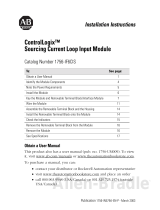 Allen-Bradley ControlLogix 1756-IF6CIS Installation Instructions Manual
Allen-Bradley ControlLogix 1756-IF6CIS Installation Instructions Manual
-
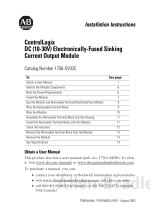 Allen-Bradley ControlLogix 1756-OV32E Installation Instructions Manual
Allen-Bradley ControlLogix 1756-OV32E Installation Instructions Manual
-
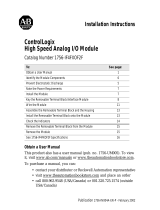 Allen-Bradley ControlLogix 1756-IF4FXOF2F Installation Instructions Manual
Allen-Bradley ControlLogix 1756-IF4FXOF2F Installation Instructions Manual
-
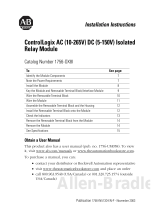 Allen-Bradley ControlLogix 1756-OX8I Installation Instructions Manual
Allen-Bradley ControlLogix 1756-OX8I Installation Instructions Manual
-
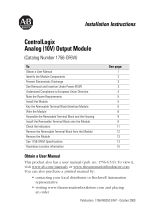 Allen-Bradley ControlLogix 1756-OF6VI Installation Instructions Manual
Allen-Bradley ControlLogix 1756-OF6VI Installation Instructions Manual
-
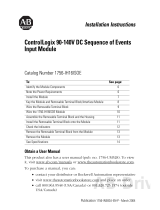 Allen-Bradley ControlLogix 1756-IH16ISOE Installation Instructions Manual
Allen-Bradley ControlLogix 1756-IH16ISOE Installation Instructions Manual
-
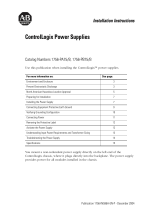 Allen-Bradley ControlLogix 1756-PA75/B Installation Instructions Manual
Allen-Bradley ControlLogix 1756-PA75/B Installation Instructions Manual
-
Allen-Bradley 1756-OV16E Installation Instructions Manual
-
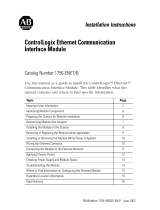 Allen-Bradley ControlLogix 1756-ENET/B Installation Instructions Manual
Allen-Bradley ControlLogix 1756-ENET/B Installation Instructions Manual
-
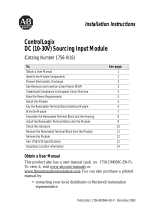 Allen-Bradley ControlLogix 1756-IB16D Installation Instructions Manual
Allen-Bradley ControlLogix 1756-IB16D Installation Instructions Manual





























